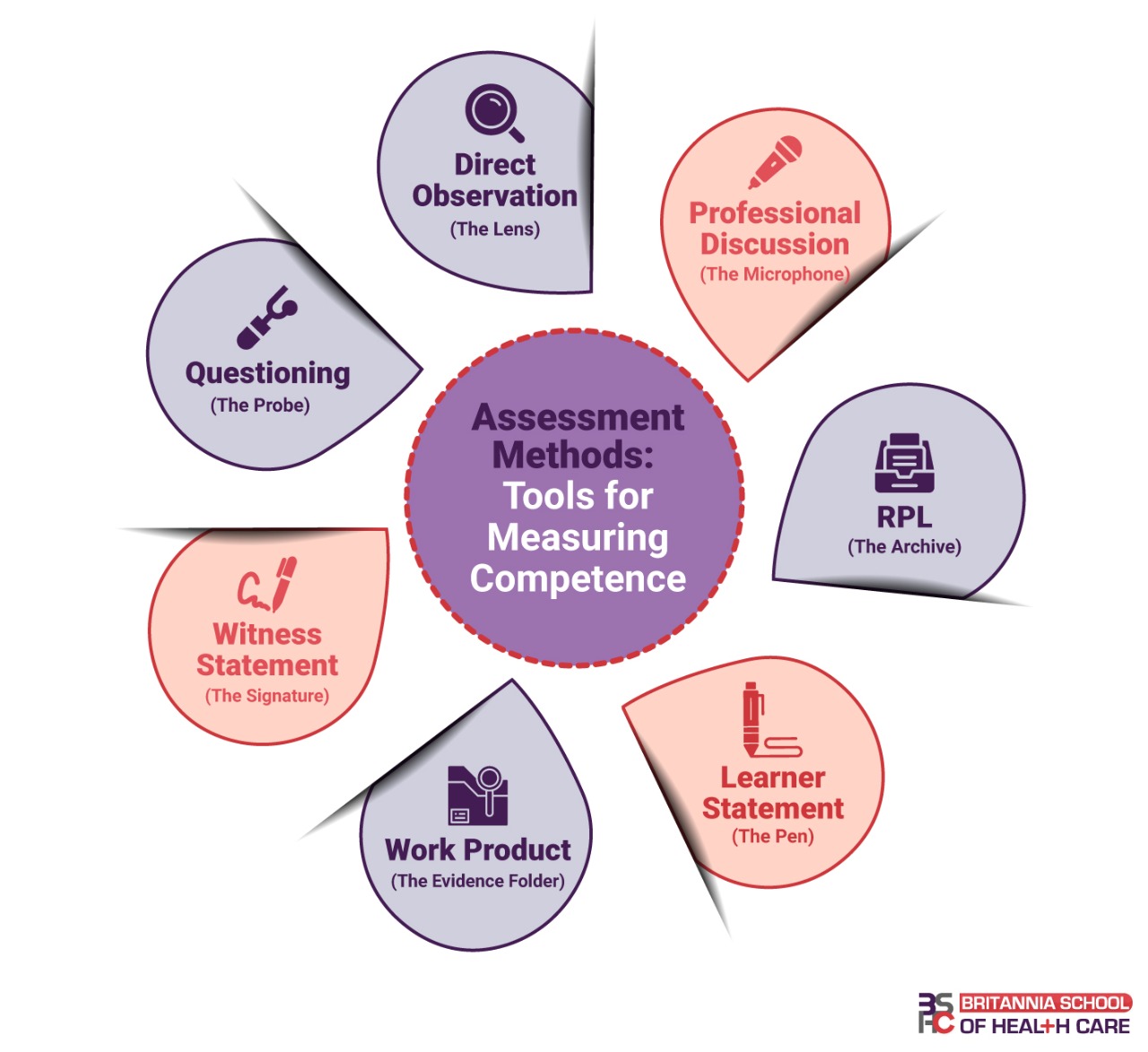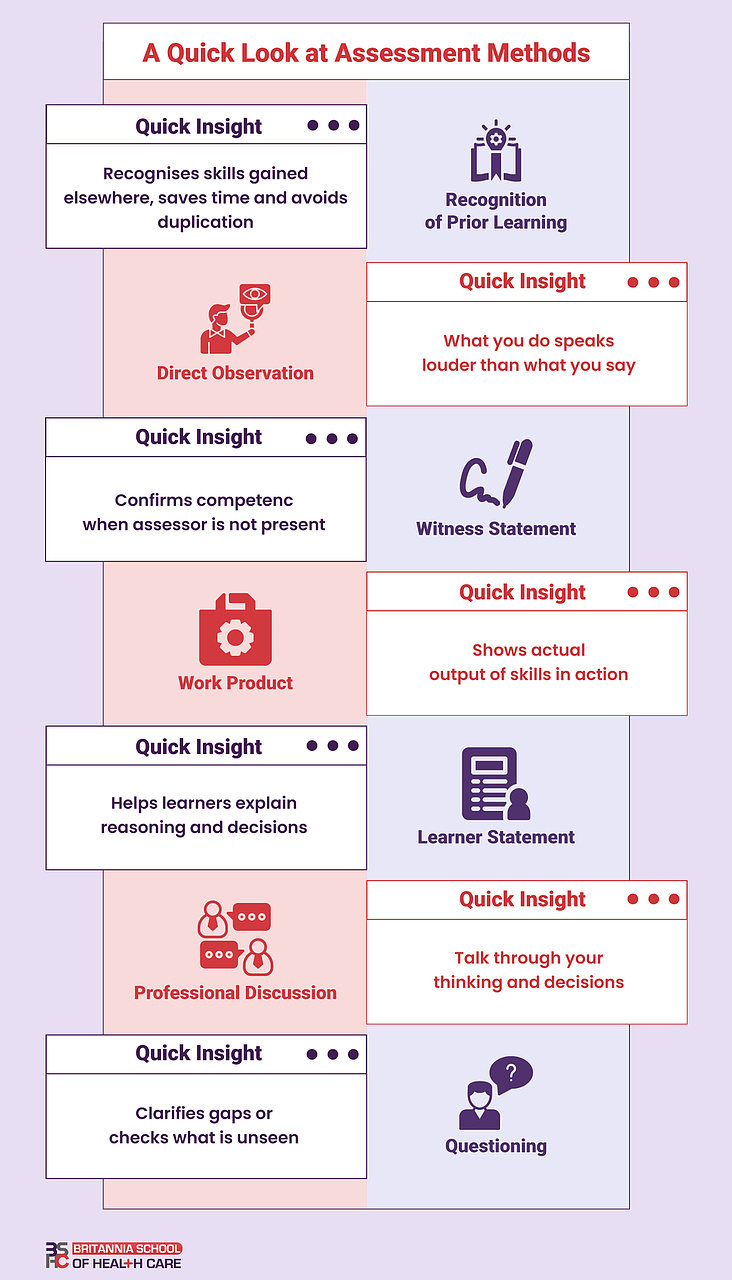In the contemporary educational landscape, assessing how effectively teaching is delivered is just as important as assessing how well students learn. Teaching assessment plays a vital role in improving instructional practices, enhancing student learning outcomes, and ensuring accountability across educational systems.
In this blog, we explore the key methods of teaching assessment, their benefits, challenges, and best practices to implement them successfully.
Seven Methods of Assessment
Formal assessments are planned, structured, and often recorded against specific learning outcomes or qualification standards. These are commonly used in accredited qualifications, such as NVQs, Diplomas, or regulated training programmes.
Let’s explore the most widely used formal methods:
These are Recognition of Prior Learning (RPL), Direct Observation, Work Product, Learner Statement, Witness Testimony, Professional Discussion, Questioning.

1. Recognition of Prior Learning (RPL) 🧠
Recognition of Prior Learning RPL is the process of identifying and recognising a learner’s existing knowledge, skills, and experiences even if they were gained outside of formal education. RPL helps learners avoid duplication, reduce training time, and achieve qualifications more efficiently.
How It Works:
Recognition of Prior Learning (RPL) follows a structured process where the learner identifies relevant past experience, and the assessor evaluates the evidence against current qualification standards. RPL does not lower standards — the learner still needs to meet all learning outcomes.
Benefits:
- Reduces duplication of learning
- Recognises lifelong learning
- Motivates experienced learners
- Provides faster routes to full qualification
- Promotes lifelong learning and inclusivity
⚠️ Considerations:
✅Evidence must be authentic, valid, and current.
✅Requires careful documentation and mapping
Example:
- A care worker with 5+ years of experience gains credit towards a Level 3 Diploma in Adult Care by providing signed witness testimonies, job descriptions, and reflective accounts.
2. Direct Observation 👀
Direct observation involves the assessor watching the learner carry out specific tasks or responsibilities in a real or simulated environment.
How it Works:
The assessor uses a structured checklist or set of criteria to observe and document the learner’s performance while they complete relevant practical tasks or demonstrate key behaviours.
Benefits:
- Provides real-time, authentic evidence
- Assesses both practical and interpersonal skills
- Allows observation in natural or realistic settings
⚠️ Considerations:
✅Observations should be carefully planned and aligned with specific assessment criteria.
✅Assessor judgement must remain objective and free from bias.
Example:
- The assessor may observe a learner carrying out a routine task, such as handling equipment, following procedures, or interacting with others, to evaluate their competence and confidence in applying their knowledge and skills.
3. Work Product 📂
This method involves assessing actual pieces of work completed by the learner such as lesson plans, reports, learning materials, or student records.
How It Works:
- Work products (e.g. care plans, risk assessments, menus, lesson plans)
- Creative outputs (e.g. designs, displays, portfolios)
- Professional documentation (e.g. logbooks, case studies)
Benefits:
- Shows what learners can produce independently
- Provides clear, tangible evidence of learning
- Helps assess skills like critical thinking, planning, and documentation
- Can be completed at the learner’s own pace
⚠️ Considerations:
✅Evidence must be the learner’s own work.
✅Should be supported by explanations or rationale where required
Example:
- A learner in an adult care qualification may submit a portfolio containing care plans they have contributed to, daily log entries, risk assessments, and records of communication with colleagues or service users, demonstrating their ability to apply knowledge and maintain professional standards in practice.
4. Learner’s Statement 
A learner’s statement is a personal account written or recorded by the learner explaining what they know, understand, or can do.
How It Works:
Learners describe how they meet specific criteria based on past experiences or current understanding, often as part of reflective practice.
Benefits:
- Encourages self-reflection
- Adds depth to assessment evidence
- Adds depth to assessment evidence
⚠️ Considerations:
✅Must be specific, detailed, and relevant
✅May need verification through supporting evidence
Example:
- A learner may write a statement explaining how they adapted their approach to support a service user with dementia—such as using clear, calm communication and visual prompts—to ensure the individual's comfort, understanding, and dignity were maintained during care.
5. Witness Testimony 🧾
Witness testimony is a formal method of assessment where someone who has observed the learner in a real work setting provides a written statement confirming they have demonstrated specific skills, behaviours, or knowledge. For detailed reference of Witness Testimony Please see Witness Statement: Definition, Purpose, Criteria for Expert Witness and its Use
How It Works:
A workplace supervisor, mentor, or colleague completes a statement outlining what they saw the learner do and how it met the required standard.
Benefits:
- Useful in workplace-based assessment
- Supports evidence when assessor is not present
- Adds credibility from a third-party perspective
- Helps assessors when they can’t observe every situation firsthand.
⚠️ Considerations:
✅Witness must be credible and appropriately qualified.
✅Must relate directly to assessment criteria
Example:
- A senior care worker may provide a witness statement confirming that the learner safely and professionally supported a service user with limited mobility during personal care, demonstrating effective communication, respect for dignity, and adherence to health and safety procedures.
6. Professional Discussion 💬
Professional discussion is a formal, one-to-one, structured conversation between the assessor and the learner. It allows the learner to explain, reflect, and expand on their knowledge, skills, and practical experiences, often relating directly to their job role or placement.
How It Works:
It is guided by assessment criteria and usually takes place in person or online. The discussion is planned, recorded, and used as assessment evidence often in combination with other methods like observation or portfolios.
Benefits:
- Explores depth of understanding
- Clarifies any uncertainties in other evidence
- Suitable for experienced learners who can articulate their practice
- Captures complex reasoning behind actions and decisions
- Builds rapport between learner and assessor
⚠️ Considerations:
✅Must be focused and planned
✅Responses should be recorded accurately
Example:
- During a professional discussion, the assessor may ask the learner to explain how they respond to safeguarding concerns, prompting the learner to discuss relevant policies, signs of abuse or neglect, and the appropriate steps they would take to report and document the issue in line with organisational procedures.
7. Questioning 🗣
Questioning involves asking learners questions to assess their knowledge, understanding, or reasoning. It is typically used during or after practical activities, discussions, or teaching sessions, and especially helpful when written methods are not suitable for the learner. It is a planned and structured assessment method that should be linked to specific learning outcomes or criteria.
How It Works:
Questions can be oral or written. They may follow observation or be part of a structured assessment.
Benefits:
- Tests underpinning knowledge
- Confirms validity of practical evidence
- Clarifies learner rationale and decision-making
- Encourages learner confidence and verbal communication
- Suitable for learners with additional needs
⚠️ Considerations:
✅Questions should be open-ended and varied
✅Must cover the full range of knowledge if used as the main method
✅Should not be overused as a sole method of assessment
✅Requires assessor skill to guide questioning without leading
Example:
- The assessor may ask the learner, “Can you identify sources of support available to you for planning and reviewing your own professional development in adult care?” This allows the learner to demonstrate their knowledge of resources such as supervisors, training providers, mentoring schemes, and relevant professional standards.

Final Reflections: A Holistic Approach
Integrating multiple assessment methods enhances the validity, reliability, and depth of evidence gathered. For example, direct observation can be supported by questioning to confirm understanding, work products can be enriched by a learner’s reflective statement, and RPL can be validated through discussion and supporting documentation. This triangulated approach promotes fair and robust professional judgment. Assessment is not about ticking boxes, it is about genuinely understanding what a learner knows, can do, and how they apply their skills in real-world contexts. A holistic approach caters to diverse learner needs and ensures assessments are fair, inclusive, and aligned with both learning outcomes and the context of the qualification. Effective assessors use a blend of methods to provide a comprehensive and accurate picture of learner competence.

